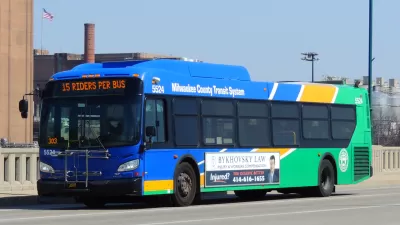Tampa Bay’s first bus rapid transit line, the SunRunner, has an official opening date.

A bus rapid transit line is coming to Tampa Bay—and it’s free to ride for the first six months. “The SunRunner, a 16-stop line, will shuttle passengers between downtown St. Petersburg and St. Pete Beach in 35 minutes each way — about 30% faster than current bus service, according to the Pinellas Suncoast Transit Authority,” reports Olivia George for the Tampa Bay Times. Construction on the SunRunner’s first station was completed in December., and the service launches on October 21.
“The SunRunner has garnered broad-base support in a region long gridlocked over plans for public transit. Colleges, business leaders, local and state officials and regional transit supporters have championed the project as a step toward reducing the growing problems of congestion and harmful emissions.” However, residents in St. Petersburg expressed opposition to the route originally proposed, which would have ended at the Don Cesar Hotel. “A revised route has it turning around at St. Pete Beach Park, near 47th Avenue.”
FULL STORY: SunRunner, first bus rapid transit line in Tampa Bay, is opening in October

Trump Administration Could Effectively End Housing Voucher Program
Federal officials are eyeing major cuts to the Section 8 program that helps millions of low-income households pay rent.

Planetizen Federal Action Tracker
A weekly monitor of how Trump’s orders and actions are impacting planners and planning in America.

Ken Jennings Launches Transit Web Series
The Jeopardy champ wants you to ride public transit.

Crime Continues to Drop on Philly, San Francisco Transit Systems
SEPTA and BART both saw significant declines in violent crime in the first quarter of 2025.

How South LA Green Spaces Power Community Health and Hope
Green spaces like South L.A. Wetlands Park are helping South Los Angeles residents promote healthy lifestyles, build community, and advocate for improvements that reflect local needs in historically underserved neighborhoods.

Sacramento Plans ‘Quick-Build’ Road Safety Projects
The city wants to accelerate small-scale safety improvements that use low-cost equipment to make an impact at dangerous intersections.
Urban Design for Planners 1: Software Tools
This six-course series explores essential urban design concepts using open source software and equips planners with the tools they need to participate fully in the urban design process.
Planning for Universal Design
Learn the tools for implementing Universal Design in planning regulations.
Heyer Gruel & Associates PA
Ada County Highway District
Institute for Housing and Urban Development Studies (IHS)
City of Grandview
Harvard GSD Executive Education
Toledo-Lucas County Plan Commissions
Salt Lake City
NYU Wagner Graduate School of Public Service





























